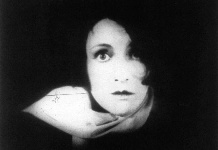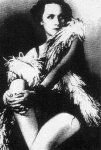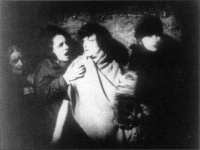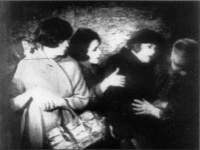| Marlene Dietrich in A Joyless Street ? |
|
Introduction |
For Decades there was this rumour that Marlene Dietrich played a minor role in this film. A dark-haired woman waiting in the butcher shop line is often mistaken for Marlene but it is actually the German actress Hertha von Walther. This is the scene popularly believed to feature Marlene Dietrich as one of the extras in line with Garbo and Asta Nielsen. When the film was filmed, Dietrich was at home nursing her threemonth - old daughter, Maria. Hertha had a much larger role in the original uncut version of the film.

A close-up of "Marlene"? Actually, it is Hertha von Walther
Die freudlose Gasse (The Joyless Street) is a film directed by Georg Wilhelm Pabst, filmed in 1925 in Germany. It's the well-known film version of a book by Hugo Bettauer and one of the first films of the movement „New Objectivity“. It stars Garbo in her second starring role. The film is often described as a morality story in which the 'fallen woman' suffers for her sins, while the more virtuous woman gets the happy end.

Marlene as she looked around Joyless Street
In 1935, ten years after The Joyless Street was made, a certain Samuel Cummins imported reels of the film to the United States. MGM paid him not to release it, on the grounds that it would embarrass Garbo. The original does not survive. In the 1950s, a reconstruction from pieces of French and Italian prints was supervised at the Museum of Modern Art by Marc Sorkin. In 1991, the Munich Film Archives further restored the film. A version with English subtitles copyrighted by Raymond Rohaur in 1958 is among the collections of the Library of Congress. More about the film HERE!
The infamous 'butcher shop' scene |
Film historicans confirmed that the 'dark haired woman' was not Marlene, yet still many Garbo and Dietrich fans has doubts. But what was the infamous 'butcher shop' scene about?
Asta Nielsen and Hertha von Walther, observe the butcher giving meat to two prostitutes, and Hertha, as a young mother, flounces toward the camera with Nielsen, hand on hip. Then, in close-up, she brushes aside her hair, lights a cigarette, and blows smoke into Nielsen's face. She has decided to sell herself to the butcher for meat. The camera pans up and down her body from the butcher's viewpoint: The deal is cut. Afterward, Hertha's character accepts the meat with shame. (The German censorship board snipped parts of this sequence as “too demoralizing for women viewers.”)
Later in the film, we see Hertha begging the swinish butcher, “My child is ill–she must have meat. Have mercy!” “I have meat,” retorts the villain, “but not for your sick brats.” When he vanishes within his shop, a marvelous lingering close-up shows fury and madness building upon Marlene's face before she runs to his door, hammers frantically on it, opens it, and storms in.
 
Hertha, Asta Nielsen and Greta
The shots that reveal the rumored 'Greta-Marlene meeting' takes place early in the film: We see Greta and 'this woman' (Hertha von Walther), together with Asta Nielsen, during the women's endless wait in line for meat outside the butcher's shop. Hertha howls to Asta that she is desperate. Standing beside them, the pale, weary Greta faints from hunger and fatigue.
Hertha holds Garbo as she slips to the ground. She clasps her unconscious form, supporting Greta firmly under one arm with her right hand, her left hand laid gently on Greta's shoulder. She lowers her to the ground, gazes down into her face, and holds her tenderly as help is called.
Who was Hertha von Walther? |
Hertha von Walther was born as in Germany. At the age of 17 she ran away from the boarding school and went to an acting school in Leipzig. There she made first experiences as an extra at the theater and at the opera. She went to Max Reinhardt in Berlin one year later and with it she managed her breakthrough on the stage. Because she couldn't earn a fortune at the theater she also took on small well paid parts for movies.

Hertha von Walther
Her first great movie success came in 1924 with Der Berg des Schicksals and played for director Georg Wilhelm Pabst in Die freudlose Gasse. In the following years she acted under his direction time and again, so in the well-known movies Geheimnisse einer Seele, Die Liebe der Jeanne Ney and Abwege.
In the sound film era joined many other great movies her filmographie and in the war time she went on tour for troops care. When the Gestapo tried to sign her on as an agent she fled to Portugal, later to Brazil. There she lived together with her second husband in a mine area.
She went back to Germany in 1960 and played at the theater at the present, later she also appeared in movies again.
The role that in The Joyless Street is not that of an extra. It is a sizable supporting role. The unnamed character wanders the Joyless Street with Asta Nielsen's murderess heroine (“Why do you insist on looking at this house every night? You are ill....”) and urges her to move back in with her parents.
Did Marlene allow that she was an extra standing in the film? |
Another rumor appeared in the Diana McLellan book The Girls: Sappho Goes to Hollywood. Marlene told a good friend of her old age, the British writer David Bret–who knew from intensive research conducted with Berlin's nightclub performers that she had been in the film–Marlene at, first, as usual, flatly denied that she was in Die freudlose Gasse with the star she always called “that other woman.”

The book
Then she conceded, “That one was pure kitsch. I don't even want to remember it, let alone talk about it.” When it was plain that there was no escaping the truth, she actually giggled: “Yes,” she said to Bret, “and in the end, I killed the butcher.” This terribly bloody and violent scene near the film's end, in which Marlene hacks the butcher to death with his own meat ax, was completely excised by the German censors.
In the remaining version of the film, it is not clear exactly who killed the man. But, a few scenes after her maddened entry, we see 'this woman' running insanely from the shop, her arms windmilling crazily in a long tracking shot, with the butcher's dog trotting at her heels.
Are those the Dietrich legs? We also see a raging mob, before the dead butcher's bloody head lolls against a window. Anyone in the mob could have killed him. Diana McLellan writes that the conclusion is obvious: Marlene had to be in the film to know about that scene.
|